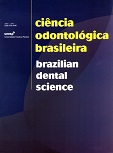Evaluation of translucency of a nanofilled and a microhybrid resin composites
DOI:
https://doi.org/10.14295/bds.2012.v15i3.825Resumo
Objectives: Color selection is a relevant issue to determine clinical success of esthetic restorations. However as multiple layer technique have been applied, opalescence and translucency parameters are also significant to allow resin composite to match tooth structure. Thus, the aim of this study was to compare different resin composites commonly launched in market to provide enamel translucency effect. Material and Methods: Four resin composites of shade A1 for enamel were tested: nanotechnology composites Filtek Z350 (F) and Grandio (G) were compared to microhybrid composites Filtek Z250 (Z) and Master Fill (M). Eight cylindrical specimens of each resin composite were prepared (6 mm x 2.5 mm), finished and individually stored in distilled water. The color analysis was performed following Cielab system parameters using a spectophotometer (Esfera -X-Rite-SP62 and X-Riteccolor Master CM2). Readings were processed using standard white and black backgrounds. Translucency parameter (TP) of these materials were calculated through the formula TP= [(Lw- Lb)2+ (aw-ab)2 + (bw-bb)2]1/2. Data were statistically analyzed and as a normal distribution was verified, they were submitted to one-way ANOVA and Tukey tests with ?= 0.05 preset. Results: Mean and standard deviations were: F= 35.54+0.34; Z= 39.11+0.39; G= 40.93+0.38 e M= 41.41+0.34. Greater values of translucency were observed to G and M without significant differences between them, and the lower values were attributed to F and Z. Conclusion: The translucency of each material was material dependent. It is suggested that small particle size provokes reduction of translucency of resin composites when enamel shade materials are compared.Downloads
Downloads
Arquivos adicionais
Publicado
Como Citar
Edição
Seção
Licença
TRANSFERÊNCIA DE DIREITOS AUTORAIS E DECLARAÇÃO DE RESPONSABILIDADE
Toda a propriedade de direitos autorais do artigo "____________________________________________________________________" é transferido do autor(es) para a CIÊNCIA ODONTOLÓGICA BRASILEIRA, no caso do trabalho ser publicado. O artigo não foi publicado em outro lugar e não foi submetido simultaneamente para publicação em outra revista.
Vimos por meio deste, atestar que trabalho é original e não apresenta dados manipulados, fraude ou plágio. Fizemos contribuição científica significativa para o estudo e estamos cientes dos dados apresentados e de acordo com a versão final do artigo. Assumimos total responsabilidade pelos aspectos éticos do estudo.
Este texto deve ser impresso e assinado por todos os autores. A versão digitalizada deverá ser apresentada como arquivo suplementar durante o processo de submissão.




























